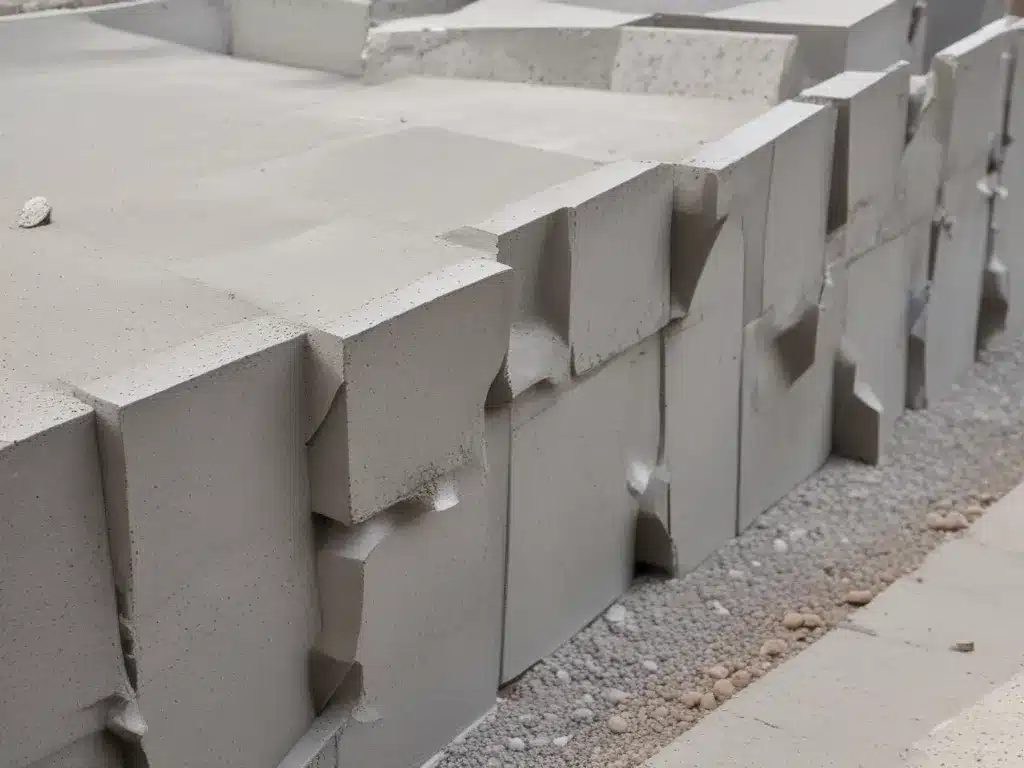
A Greener Revolution in Construction
Imagine a material that’s not only stronger than regular concrete but also way kinder to the planet. Sounds like sci-fi, right? Well, let me introduce you to geopolymer concrete – the eco-friendly rockstar that’s shaking up the construction industry.
As someone who’s always been passionate about sustainable living, I’ve been keeping a close eye on this exciting development. And let me tell you, geopolymer concrete is no joke. It’s like the Tesla of building materials – sleek, innovative, and ready to leave a smaller carbon footprint.
But before we dive into the nitty-gritty, let’s start with the basics.
What the Heck is Geopolymer Concrete?
Okay, so geopolymer concrete is a type of concrete that’s made by combining aluminosilicate materials (like fly ash or slag) with an alkaline activator solution. Now, I know that sounds like a mouthful of chemistry jargon, but bear with me.
Unlike regular concrete, which uses Portland cement as its primary binder, geopolymer concrete relies on a chemical reaction between the aluminosilicate materials and the alkaline solution to form a solid, rock-like material.
This process is not only more environmentally friendly (more on that later), but it also results in a concrete that’s incredibly strong and durable. We’re talking compressive strengths up to 30% higher than conventional concrete!
The Eco-Friendly Advantage
Now, let’s talk about the elephant in the room (or should I say, the carbon footprint?). Traditional concrete production is a major contributor to greenhouse gas emissions, accounting for a whopping 8% of global CO2 emissions.
But with geopolymer concrete, we’re taking a big step towards a more sustainable future. Here’s why:
-
Lower CO2 Emissions: The production process for geopolymer concrete doesn’t involve the calcination of limestone, which is a major source of CO2 emissions in traditional cement production.
-
Recycled Materials: Geopolymer concrete often uses industrial by-products like fly ash and slag as its main ingredients, diverting these materials from landfills and reducing the need for virgin raw materials.
-
Energy Efficiency: The curing process for geopolymer concrete requires lower temperatures and less energy compared to traditional concrete, further reducing its carbon footprint.
It’s like a win-win-win situation for the environment!
Strength and Durability: Putting Regular Concrete to Shame
But it’s not just about being eco-friendly; geopolymer concrete is also a serious powerhouse when it comes to strength and durability. Think of it as the Chuck Norris of building materials.
For starters, geopolymer concrete has a higher compressive strength than regular concrete, making it ideal for high-load applications like bridges, high-rise buildings, and infrastructure projects.
But that’s not all. Geopolymer concrete is also more resistant to fire, acid, and chemical attacks, ensuring that structures built with this material have a longer lifespan and require less maintenance.
And let’s not forget about its ability to withstand extreme temperatures. Geopolymer concrete can maintain its structural integrity and strength in both freezing and scorching conditions, making it a perfect choice for projects in harsh environments.
It’s like having a superhero on your construction team, capable of withstanding anything Mother Nature throws its way!
Real-World Applications: From Buildings to Bridges
So, you might be wondering, “That’s all well and good, but where can I actually see geopolymer concrete in action?”
Well, let me tell you, this wonder material is already making waves in the construction world. From residential homes to commercial buildings, and even massive infrastructure projects, geopolymer concrete is proving its worth on job sites around the globe.
Take, for example, the iconic Sydney Opera House. During its recent renovations, geopolymer concrete was used to repair and strengthen the iconic shell-shaped roof, ensuring that this architectural masterpiece will stand tall for generations to come.
Or how about the Mangalore Airport in India? This state-of-the-art airport features geopolymer concrete in its runway and taxiways, providing a durable and long-lasting surface that can withstand the weight of heavy aircraft and harsh weather conditions.
And let’s not forget about the Rheinau Bridge in Switzerland, a stunning structure that showcases the versatility and strength of geopolymer concrete. This bridge, spanning over the Rhine River, was constructed using geopolymer concrete and is designed to withstand the weight of heavy trucks and the harsh Swiss winters.
These are just a few examples of the many projects that are embracing the power of geopolymer concrete. As the demand for sustainable and high-performance building materials continues to grow, we can expect to see even more impressive structures incorporating this innovative material.
The Future of Construction: Embracing Geopolymer Concrete
As an avid supporter of sustainable living and eco-friendly practices, I can’t help but be excited about the potential of geopolymer concrete. Not only does it offer a greener alternative to traditional concrete, but it also promises to revolutionize the way we build our cities and infrastructure.
Imagine a world where our buildings and bridges are not only stronger and more durable but also kinder to the planet. A world where construction projects leave a smaller carbon footprint and contribute to a more sustainable future.
Of course, like any new technology, there are still challenges to overcome, such as increasing awareness and adoption, optimizing production processes, and ensuring consistent quality control. But with the collective efforts of researchers, engineers, and construction professionals, I have no doubt that geopolymer concrete will continue to make strides and become a mainstream building material.
So, whether you’re a homeowner looking to build an eco-friendly abode, a developer planning a high-rise project, or a civil engineer working on the next big infrastructure endeavor, consider embracing the power of geopolymer concrete. Not only will you be contributing to a more sustainable future, but you’ll also be at the forefront of a revolutionary building material that’s redefining the construction industry.
And who knows? Maybe one day, geopolymer concrete will be as ubiquitous as its traditional counterpart, and we’ll look back on this time as the beginning of a greener revolution in construction.
For more information on geopolymer concrete and how Atchison Construction can help you incorporate this innovative material into your next project, visit https://atchisonconstructioninc.com/ or give us a call. We’re always eager to chat about the latest advancements in sustainable building practices and how we can work together to create a more eco-friendly future.





